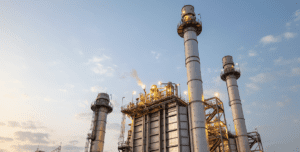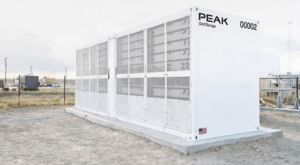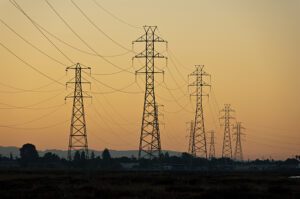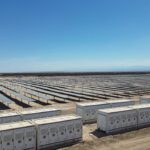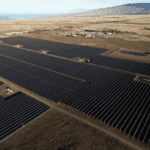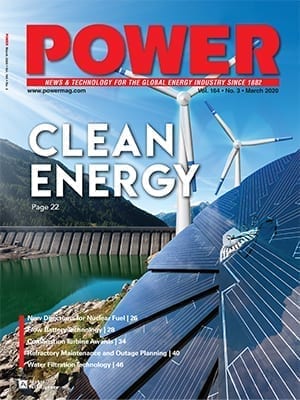Egypt is among the Middle Eastern countries looking to accelerate the growth of renewable energy. The country was among the first in Africa to embrace renewables; Egypt had brought 555 MW of wind power generation online as early as 2012. Development stalled, though, as government support aligned behind natural gas-fired generation.
A push for renewables began in earnest after Russia’s invasion of Ukraine drove up prices for natural gas, and Egypt began exporting more gas to Europe. The promise of a major economic impact from hydrogen production, specifically green hydrogen using renewable energy, also prompted calls for more investment in renewable energy in a country with significant solar and wind resources.
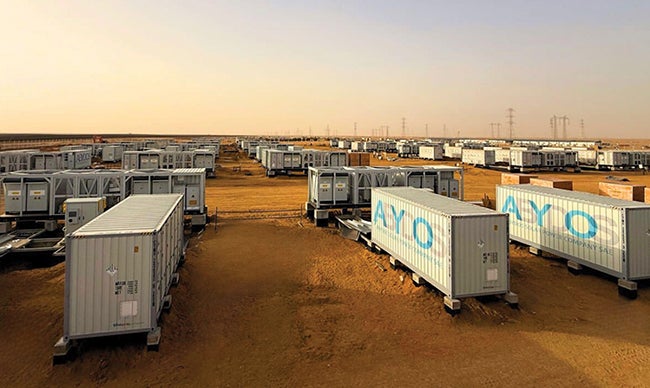 |
|
1. The 300-MWh Abydos BESS project, which is aligned with a 500-MW solar power facility, makes the site near Aswan in southern Egypt home to the country’s first utility-scale integrated solar-plus-storage installation. Courtesy: Trina Storage |
Energy storage also has entered the picture. AMEA Power, a renewable energy developer headquartered in Dubai in the United Arab Emirates (UAE), in August announced a 300-MWh battery energy storage system (BESS) had entered operation alongside a 500-MW solar photovoltaic (PV) plant that was commissioned in December of last year. Trina Storage, a global energy storage solutions company and part of Trina Solar (also known as Trinasolar), said the Abydos BESS project (Figure 1) was delivered ahead of its scheduled commercial operation date and provides a new benchmark for large-scale energy storage projects in North Africa. The BESS supports the solar power facility in Aswan Governorate in Egypt. Officials said the project is Egypt’s first utility-scale integrated solar and storage installation. Trina Storage supplied its advanced Elementa 2 platform for the project. The platform covers the full scope, from in-house LFP (lithium iron phosphate) battery cells and DC compartments to the AC side, enabling connection to the national grid.
“Faced with the extremely high temperatures and complex power grid environment in the Middle East and North Africa, we completed the 300-MWh energy storage project from equipment installation to grid connection and delivery in just 60 days,” said Vincent Wu, global sales vice president and Middle East and Africa Market Unit head at Trinasolar. “This achievement sets a new regional benchmark for rapid deployment and localized delivery. More importantly, it contributes directly to Egypt’s national energy stability by enabling the use of solar power even after sunset and reducing strain on the grid during peak hours. It’s a clear demonstration of how fast, reliable energy storage solutions can support a country’s energy security goals.”
“We are proud to bring this landmark battery storage project online, strengthening the resilience of Egypt’s electricity grid while supporting the country’s renewable energy ambitions,” said Hussain Al Nowais, chairman of AMEA Power. “This commissioning milestone reaffirms our long-term commitment to Egypt as a key partner in driving innovation and sustainability across Africa.” AMEA Power has more than 2.6 GW of clean energy projects in operation, under construction, or nearing construction in several countries, including Burkina Faso, Djibouti, Egypt, Côte d’Ivoire, Jordan, Morocco, Togo, and Tunisia.
Officials said the BESS project involved Trina Storage’s technical and project teams, who worked in coordination with other partners to customize the solution for a harsh desert environment. Trina Storage’s Elementa 2 system is specifically engineered for desert locations, with features such as smart liquid cooling, enabling long-term performance and reliability under harsh climatic conditions, according to the company. Officials said Elementa 2 is designed for rapid installation and seamless integration with large-scale solar PV systems. Trina Storage said the project supports Egypt’s Vision 2030 renewable energy goals and national energy security efforts.
Egypt’s Ministry of Electricity and Renewable Energy earlier this year said the country is set to supply at least 30% of its total energy mix from renewable energy by 2030, which is short of some announced goals but far more than what is currently deployed. The agency in a June report about its goals for renewable energy said the country will exceed its targets of 21 GW of renewable energy, and 1.9 GW of battery energy storage, and will reach 25.1 GW of renewables and 3.3 GW of BESS by the end of the decade. Officials said the renewable energy figure includes 13.7 GW of wind power, 8.5 GW of solar, and 2.8 GW of hydropower.
Egyptian Prime Minister Mostafa Madbouly at the COP29 conference in November 2024 said the country is aiming to have renewable energy supply 42% of its electricity by 2030, but said international support is needed to achieve that mark. Madbouly, during an address at COP29 said, “Without the necessary backing, critical infrastructure improvements remain out of reach, placing our target at serious risk.” As an example of that foreign investment, the International Finance Corp. supported the Abydos BESS with a $72-million debt package. “Meeting Egypt’s rising energy demand—especially in the summer—requires bold solutions, and we are proud to deepen our collaboration with a ready-to-scale partner like AMEA Power,” said Makhtar Diop, IFC’s managing director. “This investment delivers sustainable infrastructure that strengthens the grid today while laying the foundation for a cleaner, more resilient energy future in Egypt. This is modeling efficient transition—one that brings value for the country through advanced technologies and skills.”
Egypt had just more than 59 GW of installed power generation capacity as of year-end 2024, with just 11% of that figure coming from renewable energy. The rest is from fossil fuels, mostly natural gas and oil, with 82% of the country’s power last year produced at gas-fired power plants. That includes 14.4 GW of gas-fired generation capacity from the Egypt Megaproject, a set of three gas-fired power plants powered by Siemens technology. The Megaproject received POWER’s Plant of the Year award in 2019.
Construction of the Benban Solar Park, a 1.8-GW facility near Aswan in southern Egypt, sparked renewed interest in renewables when it came online late in 2019. The multibillion-dollar project was developed by more than 30 companies from 12 countries, many of them entering the Egyptian market for the first time. The country’s oil and gas industry has received most of the attention from foreign investors until then. Now several more renewable energy projects, including the Abydos BESS installation, are either online or in the works.
The Red Sea Wind Energy Consortium in July announced the start of commercial operations of a 650-MW onshore wind farm near Ras Ghareb, Egypt, and said the project’s final 150-MW phase was commissioned four months ahead of schedule. The first two phases of that project—306 MW and 194 MW—also were completed early, with the first phase online in December of last year (four months early) and the next phase placed into service in April of this year, six months ahead of schedule. The Masdar consortium, which includes UAE-headquartered energy giant Masdar, along with Masdar-led Infinity Power and Hassan Allam Utilities (part of Hassan Allam Holding), is developing a 10-GW onshore wind farm in West Suhag. That project is considered the world’s largest onshore wind farm development.
AMEA is developing a 5-GW wind farm in the Gulf of Suez that is expected to be operational early next year. Alcazar Energy Partners, a UAE-based independent investor in renewable energy, late last year announced it had signed an agreement with the Egyptian Electricity Transmission Company (EETC) and the New and Renewable Energy Authority for development of a 2-GW onshore wind power project. In addition, Hassan Allam Holding and ACWA Power are co-developing a 1.1-GW onshore wind farm.
Masdar, Infinity Power, and Hassan Allam Utilities in November of last year signed a deal with EETC that includes two power purchase agreements for electricity from solar energy projects with combined capacity of 1.2 GW, along with 720 MWh of battery energy storage.
Mahmoud Essmat, Egypt’s minister of Electricity and Renewable Energy, has held meetings with foreign groups to discuss cooperation on renewable energy. Essmat recently met with officials from Greece to review progress on the Egypt-Europe electricity interconnection project that includes Greece. Officials said Essmat’s meetings are part of Egypt’s national strategy to make the country a regional hub for energy, including diversifying energy sources, maximizing the country’s returns from its natural resources, and strengthening the stability and resilience of the Egyptian grid through interconnections with nearby countries.
—Darrell Proctor is a senior editor for POWER.


